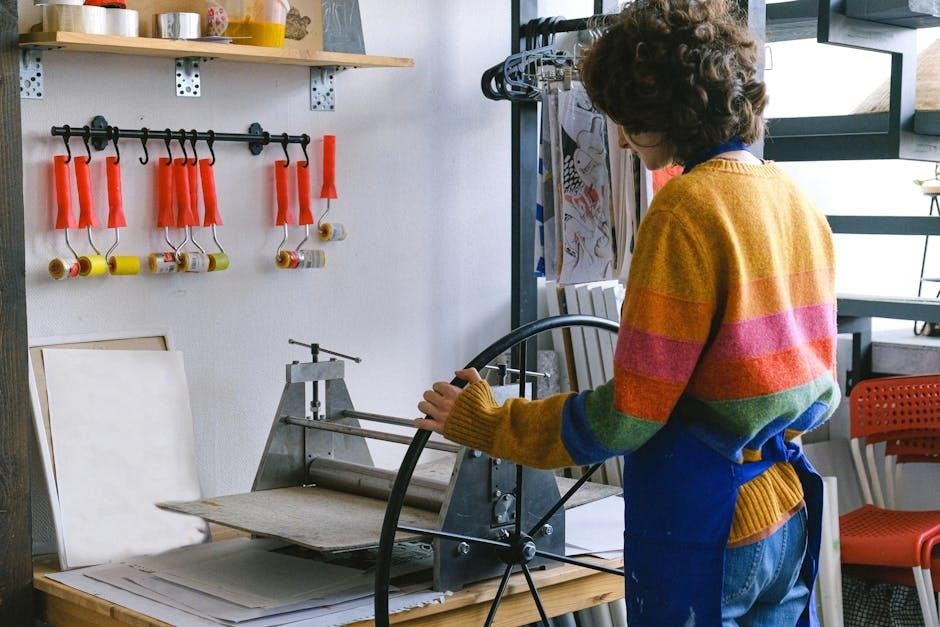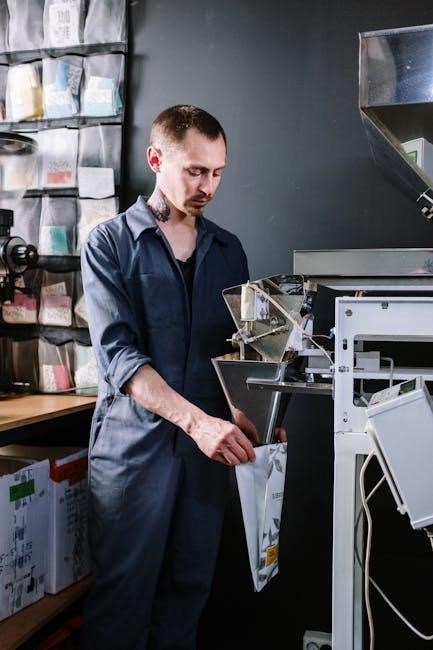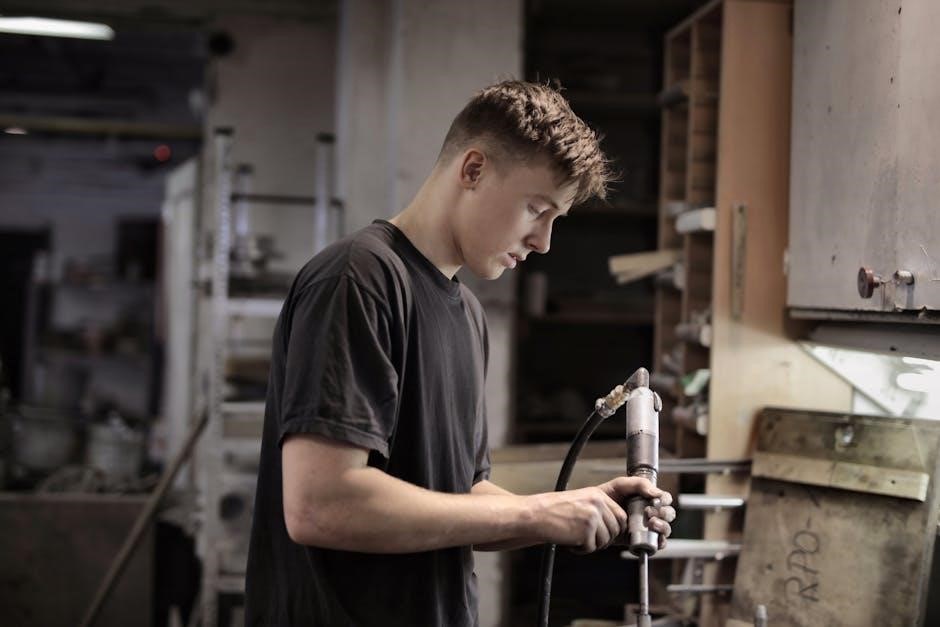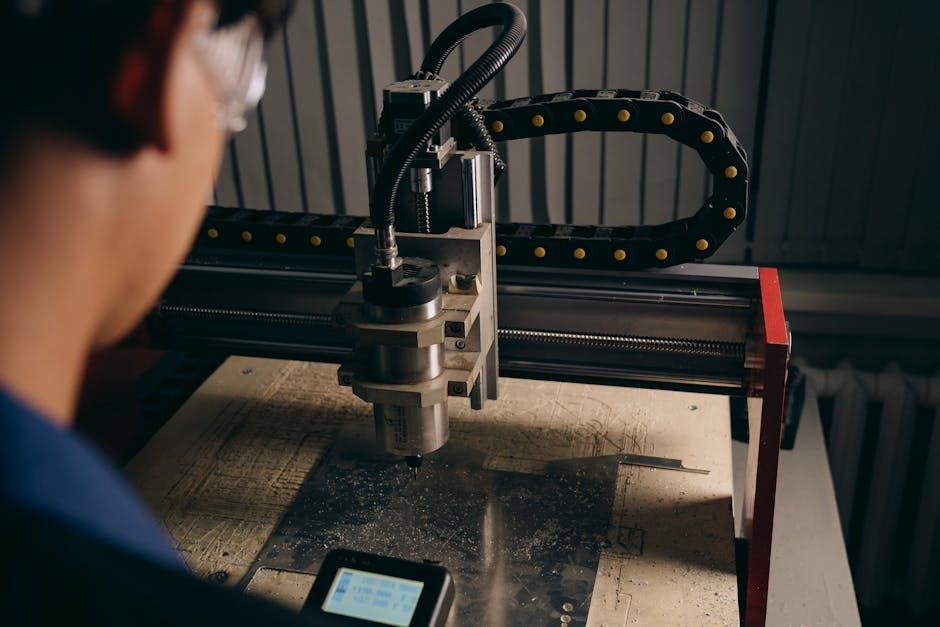manual cnc machine

Manual CNC machines combine traditional machining techniques with computerized numerical control, offering precise manufacturing while retaining operator involvement for specific tasks, blending efficiency with human expertise in production processes.

1.1 What is a Manual CNC Machine?
A manual CNC machine integrates computer numerical control with operator-directed processes, allowing for precise manufacturing through programmed instructions while enabling hands-on adjustments. This hybrid approach combines automation with human oversight, making it ideal for customized or complex tasks where real-time decisions are crucial. Unlike fully automated CNC machines, manual CNC machines require operator input for certain operations, offering flexibility and adaptability in production. They are often preferred in smaller workshops or industries needing tailored solutions. The operator’s role involves executing commands and making adjustments, which can enhance precision and accommodate unique material variations or design requirements. However, this reliance on human skill can introduce variability, emphasizing the need for trained personnel. Manual CNC machines thus provide a cost-effective, adaptable alternative to fully automated systems, balancing technological advancement with human expertise.
1.2 Differences from Conventional CNC Machines
Manual CNC machines differ from conventional CNC machines primarily in their operational approach. Conventional CNC machines are fully automated, relying solely on pre-programmed instructions to execute tasks without human intervention. In contrast, manual CNC machines require operator input for certain functions, allowing for real-time adjustments and customization. While conventional CNC machines prioritize speed and consistency in high-volume production, manual CNC machines are ideal for low-volume, high-precision tasks where flexibility is essential. Additionally, manual CNC machines often have a lower initial investment cost and are more accessible to smaller manufacturers or workshops. However, they may lack the high-speed capabilities and continuous operation of fully automated systems. This distinction makes manual CNC machines a practical choice for industries requiring specialized, intricate, or variable manufacturing processes where human expertise and adaptability are advantageous.
1.3 Importance in Modern Manufacturing
Manual CNC machines play a crucial role in modern manufacturing, offering a balance between automation and human oversight. They are particularly valued for their precision and versatility, enabling manufacturers to produce complex components with high accuracy. Unlike fully automated systems, manual CNC machines allow for real-time adjustments, making them ideal for small-batch production or custom orders. Their cost-effectiveness and ease of operation make them accessible to smaller manufacturers and startups, fostering innovation and competition in the industry. Additionally, manual CNC machines are often used in prototyping, where rapid iteration and flexibility are essential. They also serve as a bridge for businesses transitioning from traditional machining to automated processes. Overall, manual CNC machines remain a vital tool in modern manufacturing, supporting diverse production needs and maintaining the quality expected in today’s competitive market.

History and Evolution of CNC Technology
Manual CNC machines trace their origins to the 1950s, evolving from early automation concepts to precise, computer-controlled systems, revolutionizing manufacturing with enhanced accuracy and efficiency over time.
2.1 Early Development of CNC Technology
The origins of CNC (Computer Numerical Control) technology date back to the 1940s and 1950s, when the U.S. Air Force and MIT collaborated on the development of numerical control systems. These early systems used punched cards to input instructions, marking the beginning of automated machining. The first CNC machines emerged in the 1960s, integrating computers for precise control. Initially, they were large, expensive, and limited to complex aerospace applications. Over time, advancements in computing power and software made CNC technology more accessible and versatile. The transition from manual machining to CNC revolutionized manufacturing, enabling higher precision and efficiency. By the 1970s, CNC machines began to adopt microprocessors, further enhancing their capabilities. This foundational period laid the groundwork for modern CNC systems, including manual CNC machines, which combine traditional machining techniques with computerized control.
2.2 Transition from Manual to Automated Systems
The shift from manual machining to automated CNC systems was driven by the need for greater precision, consistency, and efficiency. Early CNC machines relied on punched tapes and basic computers, but advancements in technology, such as servo motors and microprocessors, enabled smoother transitions. Manual systems required skilled operators for precise control, while automated CNC machines reduced reliance on human intervention. This transition began in the 1970s, with CNC becoming more widespread in the 1980s. Automated systems offered faster production, reduced errors, and the ability to handle complex tasks. The integration of CAD/CAM software further enhanced design-to-manufacturing workflows. Despite the rise of automation, manual CNC machines retained their value in smaller-scale or specialized operations, blending traditional craftsmanship with modern technology. This evolution balanced the benefits of automation with the flexibility of manual control, catering to diverse manufacturing needs.

Types of CNC Machines
Manual CNC machines offer precise control, while automated systems provide high-speed production. CNC machining centers and specialized machines cater to specific tasks, ensuring flexibility and efficiency in manufacturing.
3.1 Manual vs. Automated CNC Machines
Manual CNC machines require operator intervention for setting up and executing tasks, offering flexibility for custom projects. Automated CNC machines run pre-programmed instructions with minimal human input, enhancing efficiency and consistency.

3.2 Types of CNC Machining Centers
CNC machining centers are categorized based on their functionality, size, and purpose. Vertical machining centers (VMCs) are the most common, suitable for milling and drilling operations. Horizontal machining centers (HMCs) are ideal for large-scale production and complex parts, often featuring pallet systems for efficient part loading. Multi-tasking machining centers combine milling, turning, and grinding in one machine, reducing production time. Compact machining centers are designed for small parts and limited workspace, while large, heavy-duty models handle massive components. Each type is tailored for specific manufacturing needs, ensuring precision and efficiency in various industrial applications.
3.3 Specialized CNC Machines for Specific Tasks
Specialized CNC machines are designed to perform unique or highly specific manufacturing tasks. For instance, 5-axis CNC machines are used for complex geometries, enabling precise cutting from multiple angles. CNC lathes are optimized for turning operations, such as creating cylindrical or spherical parts. CNC routers are ideal for woodworking and plastic machining, while CNC grinders are tailored for surface finishing. Additionally, there are CNC laser and waterjet cutting machines for precise material cutting. Each specialized machine is engineered to address specific industrial needs, offering enhanced productivity and accuracy in niche applications. These machines are often customized to meet the demands of particular industries, such as aerospace, automotive, or medical device manufacturing. Their versatility and precision make them indispensable in modern manufacturing workflows.

Key Components of Manual CNC Machines
Manual CNC machines consist of mechanical components, control systems, and essential tools. They include spindles, axes, and a control panel for precise operation and functionality.
4.1 Mechanical Components
The mechanical components of manual CNC machines are essential for their operation. These include the spindle, which holds and rotates cutting tools, and the axes (X, Y, Z) that enable precise movement. Ball screws and linear guides facilitate smooth and accurate axis traversal. The machine also features a coolant system to prevent overheating during machining; The table or bed secures the workpiece, ensuring stability. Stepper or servo motors drive the axes, providing the necessary torque and control for precise movements. These components collectively enable the machine to perform intricate machining tasks with high accuracy. Regular maintenance of these parts is crucial to uphold performance and longevity. Understanding these mechanical elements is vital for effective operation and troubleshooting.
4.2 Software and Control Systems
Manual CNC machines rely on sophisticated software and control systems to execute precise machining operations. The primary software includes G-code editors for programming and CNC control software, which interprets and executes the code; These systems often feature user-friendly interfaces for inputting commands and parameters. The CNC controller acts as the brain, translating G-code into mechanical movements. Many manual CNC machines also include CAD/CAM integration, enabling seamless transition from design to production. The control panel allows operators to input commands, monitor progress, and adjust settings in real-time. Advanced systems may include simulation tools to visualize the machining process before execution. These software and control systems ensure accuracy, efficiency, and repeatability in manufacturing. Regular updates and maintenance are essential to keep the software optimized and aligned with evolving machining requirements.
4.3 Accessories and Tools
Manual CNC machines often require specific accessories and tools to optimize their performance and versatility. Essential tools include cutting tools like end mills, drills, and taps, which are crucial for various machining operations. Workholding devices such as vises, clamps, and chucks are necessary to secure materials during processing. Measurement tools like calipers, micrometers, and dial indicators ensure precision and accuracy. Coolants and lubricants are also vital to prevent overheating and maintain tool longevity. Safety equipment, such as goggles and gloves, protects operators during operation. Additionally, tool kits for maintenance and setup, such as wrenches and Allen keys, are often included. These accessories and tools enhance the functionality and efficiency of manual CNC machines, enabling precise and reliable manufacturing processes. Proper selection and use of these components are critical for achieving desired results in machining tasks.

Operating Principles of Manual CNC Machines
Manual CNC machines operate by integrating G-code programming with manual inputs, enabling precise control over machining processes. Operators set parameters, monitor operations, and adjust settings as needed for accuracy and efficiency.
5.1 The Role of G-Code
G-code is the foundational programming language for CNC machines, providing precise instructions for tool movements, speeds, and operations. In manual CNC machines, G-code serves as the bridge between the control system and the mechanical components. It dictates the exact coordinates, depths, and angles for machining, ensuring accuracy and repeatability. Operators can input or modify G-code manually, allowing for customization and adaptability in production processes. While manual adjustments are possible, G-code ensures that the machine operates within predefined parameters, maintaining consistency and reducing variability. This programming language is essential for enabling manual CNC machines to perform complex tasks efficiently and precisely, making it a cornerstone of modern machining operations. Its versatility allows for both automated and manual interventions, catering to diverse manufacturing needs while upholding high standards of quality and performance.
5.2 How Manual Input Integrates with CNC
Manual input plays a crucial role in the operation of CNC machines, complementing automated processes with human oversight and precision. Operators can manually enter parameters, adjust settings, or override automatic functions to fine-tune machining operations. This integration allows for real-time adjustments, enabling the machine to adapt to specific job requirements. Manual input is often used for setup, tool changes, or troubleshooting, ensuring flexibility in production workflows. The CNC system interprets these manual commands and executes them with high accuracy, blending human expertise with machine precision. This synergy between manual and automated inputs enhances efficiency, allowing for customized machining while maintaining the benefits of CNC technology. The ability to manually intervene ensures that complex tasks can be tailored to meet exact specifications, making manual CNC machines versatile tools in modern manufacturing environments. This balance of control and automation is key to achieving optimal results.
5.3 Step-by-Step Operation Guide
Operating a manual CNC machine involves a systematic approach to ensure precision and safety. First, the operator plans the job by creating or loading the G-code program. Next, the machine is powered on, and the CNC system is initialized. Tools and workpieces are then mounted securely on the machine bed or spindle. The operator inputs the program parameters, selects the correct tools, and sets the machining coordinates. Once everything is ready, the program is executed, and the machine performs the operations as coded. The operator monitors the process, making manual adjustments if needed. After machining, the operator inspects the output, cleans the machine, and prepares for the next task. This step-by-step process ensures efficient and accurate production, leveraging both the machine’s capabilities and the operator’s expertise.

Applications and Uses of Manual CNC Machines
Manual CNC machines are widely used in various industries for precise machining tasks. They are essential for cutting, drilling, and shaping metal and plastic materials. Their versatility makes them ideal for small-scale production and custom parts.
6.1 Industries That Rely on Manual CNC Machines
Manual CNC machines are integral to various industries requiring precision machining. The automotive industry uses them for manufacturing engine parts and components. Aerospace relies on them for crafting intricate aircraft components. Industrial machinery manufacturers depend on manual CNC for custom parts production. Consumer goods industries, such as appliance and furniture manufacturing, utilize these machines for creating complex designs. Additionally, medical device manufacturers employ manual CNC machines for producing high-precision components. Even the energy sector benefits from their use in fabricating specialized equipment parts. These industries value manual CNC machines for their ability to deliver accurate results, making them indispensable in modern manufacturing workflows.
6.2 Common Manufacturing Processes
Manual CNC machines are widely used in various manufacturing processes that require precision and accuracy. One of the most common processes is milling, where materials are shaped using rotating cutting tools. Drilling and tapping are also frequent applications, creating holes and threads in parts. Turning operations, such as facing, boring, and threading, are performed on cylindrical components. Grinding and polishing tasks are handled with precision, ensuring smooth surface finishes. These machines are also used for engraving and profiling, adding intricate designs or patterns to materials. Additionally, manual CNC machines are employed for prototyping, allowing for rapid production of sample parts. Their versatility makes them essential for both small-scale and large-scale manufacturing operations, enabling the production of complex and simple components alike with high consistency and reliability.
6.3 High-Precision Engineering Tasks
Manual CNC machines excel in high-precision engineering tasks, where accuracy and attention to detail are critical. These machines are often used in aerospace and defense industries for machining complex components, such as turbine blades and engine parts, with tight tolerances. In the medical sector, manual CNC machines are employed for crafting precise surgical instruments and implants. Optical industries rely on these machines for producing high-accuracy lenses and optical components. Additionally, they are utilized in watchmaking and jewelry manufacturing for intricate designs and miniaturized parts. The ability to manually input precise commands ensures that even the most delicate tasks are executed flawlessly. This level of control makes manual CNC machines indispensable for high-precision engineering, enabling the creation of components that meet stringent quality standards.

Advantages and Benefits of Manual CNC Machines
Manual CNC machines offer cost-effectiveness, ease of operation, and adaptability, making them ideal for small-scale production and precise control, enhancing manufacturing efficiency and flexibility.
7.1 Precision and Accuracy
Manual CNC machines are renowned for their exceptional precision and accuracy, enabling intricate machining tasks with minimal error margins. By utilizing pre-programmed G-code instructions, these machines ensure consistent and repeatable results, crucial for high-precision engineering. The integration of advanced mechanical components, such as servo motors and high-resolution encoders, further enhances positional accuracy. Operators can manually fine-tune settings to achieve exacting tolerances, making these machines ideal for industries like aerospace and medical device manufacturing. The combination of automated control and manual oversight allows for precise adjustments, ensuring flawless execution of complex geometries and surface finishes. This level of accuracy not only meets demanding quality standards but also reduces material waste, making manual CNC machines indispensable in modern manufacturing workflows.
7.2 Increased Efficiency
Manual CNC machines significantly enhance manufacturing efficiency by streamlining production processes. These machines combine the precision of CNC technology with manual operation, allowing operators to optimize workflows and reduce downtime. The ability to perform complex machining tasks with minimal supervision frees up personnel for other critical tasks. Automated features, such as pre-programmed instructions and rapid tool changes, minimize setup times and accelerate production cycles. Additionally, manual CNC machines enable quick adjustments during operations, ensuring continuous productivity. This blend of automation and human oversight reduces errors and rework, further improving efficiency. As a result, manual CNC machines are highly effective in increasing throughput while maintaining high standards of quality, making them a valuable asset in modern manufacturing environments focused on maximizing output and reducing operational delays.
7.3 Reduced Human Error
Manual CNC machines significantly reduce human error by leveraging pre-programmed instructions and automated processes. Unlike purely manual machines, CNC technology ensures consistent and repeatable results, minimizing variability caused by human oversight. The use of G-code and software-driven operations eliminates errors in measurements and calculations. Additionally, real-time feedback and error detection features alert operators to potential issues before they escalate. While manual input is still required, the machine’s automated systems handle complex calculations, reducing the likelihood of mistakes. This combination of human oversight and machine precision ensures higher accuracy and reliability in manufacturing processes. As a result, manual CNC machines are particularly advantageous in industries where precision and consistency are critical, making them a reliable choice for minimizing human error and improving overall product quality.

Buying Guide for Manual CNC Machines
When purchasing a manual CNC machine, assess your specific needs, compare features, and evaluate reliability to ensure the best fit for your manufacturing requirements.
8.1 Key Considerations When Purchasing
When buying a manual CNC machine, evaluate its performance, size, and capability based on your specific needs. Consider the spindle power, travel dimensions, and material compatibility. Opt for a machine with user-friendly controls and a reliable CNC controller. Check the build quality, including the frame and component materials, to ensure durability and precision. Budget is crucial, so set a clear price range and compare features across models. Assess the seller’s customer support and after-sales services, such as warranties and maintenance options. Additionally, consider the machine’s compatibility with your existing tools and workshop setup. Prioritize energy efficiency and safety features to meet industry standards. Finally, research the manufacturer’s reputation and read reviews to ensure long-term reliability and satisfaction with your purchase.
8.2 Evaluating Suppliers and Manufacturers
Evaluating suppliers and manufacturers is critical to ensure you purchase a high-quality manual CNC machine. Research the manufacturer’s reputation, experience, and expertise in producing CNC machinery. Check for certifications and compliance with industry standards, such as ISO certifications. Review customer testimonials, case studies, and independent reviews to assess their reliability and customer satisfaction. Compare the quality of products, pricing, and warranties offered by different suppliers. Ensure the manufacturer provides adequate after-sales support, including technical assistance and spare parts availability. Verify their ability to customize machines to meet specific requirements. Consider the supplier’s financial stability and market presence to ensure long-term support. Visit facilities or attend trade shows if possible to assess their capabilities firsthand. Finally, evaluate their commitment to innovation and adherence to safety and environmental regulations. This thorough evaluation ensures you partner with a trusted and capable supplier.
8.3 Budgeting and Cost Analysis
Budgeting and cost analysis are essential steps when purchasing a manual CNC machine. Determine your budget by evaluating the initial purchase cost, maintenance, and operational expenses. Compare prices from different suppliers to ensure you are getting value for money. Consider the cost of accessories, tools, and software required for operation. Long-term costs, such as energy consumption and spare parts, should also be factored in. Assess whether the machine’s capabilities align with your production needs to avoid over-spending. Financing options, such as loans or leasing, may be necessary if the upfront cost is high. Evaluate the return on investment by considering the machine’s productivity, efficiency, and durability. Prioritize your requirements to balance cost and functionality, ensuring the machine meets your manufacturing goals without exceeding your budget.